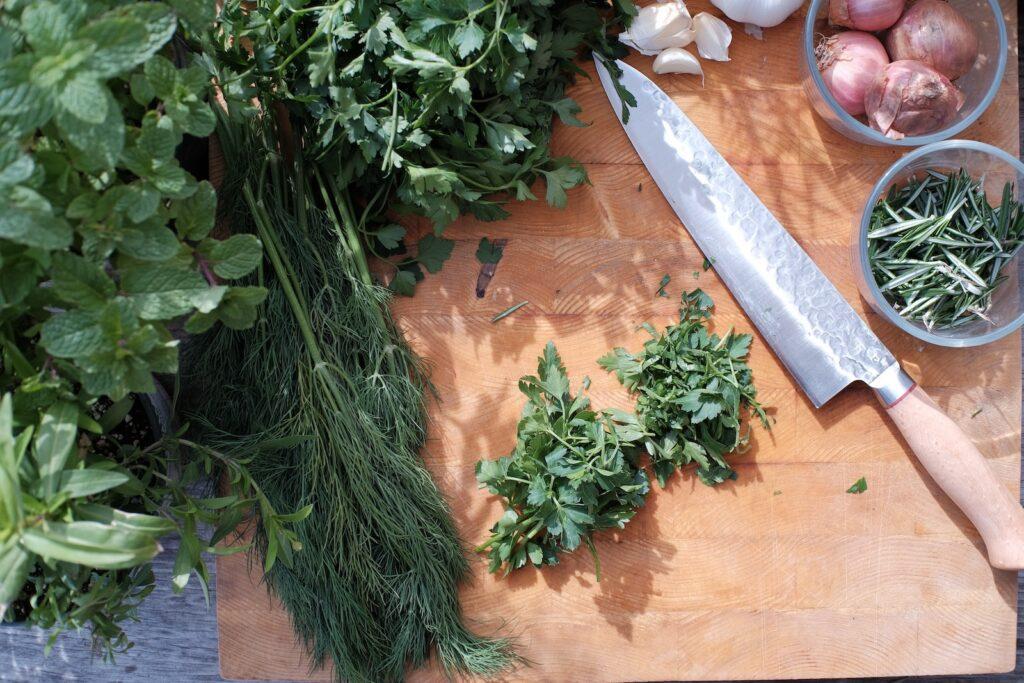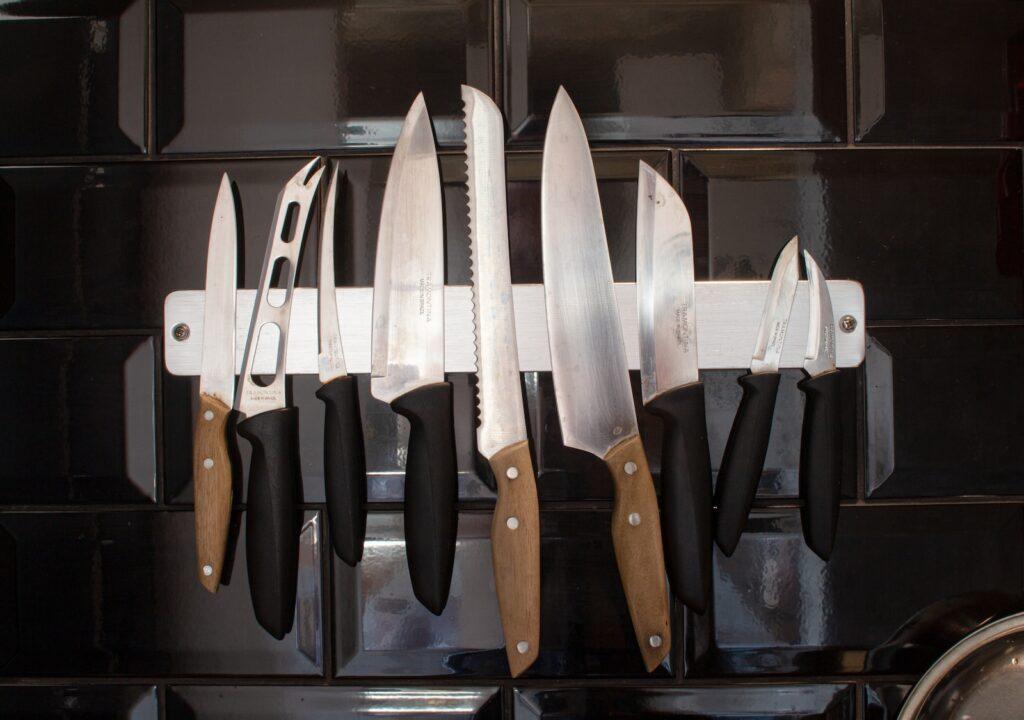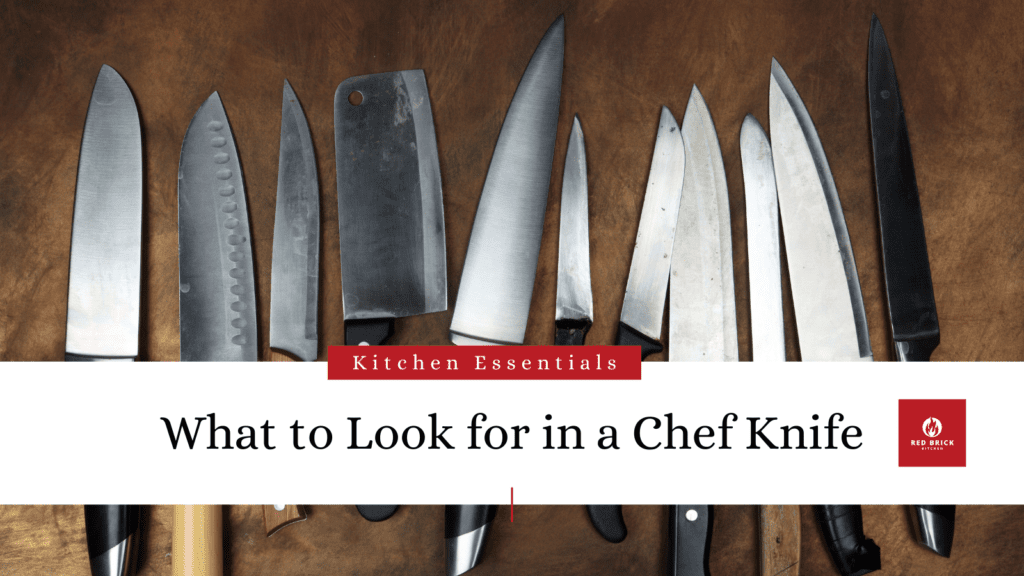A chef’s knife is often considered the workhorse of the kitchen. Whether you’re a professional chef or a home cook, having a reliable chef’s knife can make a world of difference in your culinary adventures. But with so many options available, how do you choose the right one for your needs? In this guide, we’ll delve into the essential factors to consider when looking for that perfect chef’s knife.
The Anatomy of a Chef Knife
Before we dive into the specifics, let’s get acquainted with the anatomy of a chef’s knife. These knives consist of several key components: the blade, handle, bolster, and tang. Each part plays a crucial role in the knife’s performance and durability.
Blade: The blade is the heart of the chef’s knife. It’s where the cutting action takes place. Blades can vary in length, material, and shape, and we’ll explore these aspects in more detail shortly.
Handle: The handle provides the grip and control needed for precise cutting. Handles come in various materials, with some offering better ergonomics and grip than others.
Bolster: The bolster is the thick junction between the blade and the handle. It adds balance to the knife and protects your hand from accidentally slipping onto the blade.
Tang: The tang is the portion of the blade that extends into the handle. A full tang (extending the full length of the handle) is a sign of a durable knife.

Types of Chef Knives
Chef knives come in different types, each with its own set of characteristics and purposes. The main categories include:
- French Chef Knife: Known for its all-purpose versatility and fine precision.
- German Chef Knife: Recognized for its durability, weight, and suitability for heavy-duty tasks.
- Japanese Chef Knife: Renowned for its sharpness, lightweight design, and agility.
Understanding the differences between these types will help you choose the one that aligns with your cooking style.
Blade Material
The material of the blade significantly impacts a knife’s performance. Common blade materials include stainless steel, carbon steel, and Damascus steel.
- Stainless Steel: Known for its rust resistance and easy maintenance, making it ideal for everyday use.
- Carbon Steel: Loved for its exceptional sharpness and edge retention, but it requires more care to prevent rust.
- Damascus Steel: A premium option, known for its beauty and exceptional sharpness. It often consists of multiple layers of steel.
Each material has its pros and cons, so consider your maintenance preferences and cutting needs.
Blade Length and Shape
The blade’s length and shape are crucial factors to consider. Longer blades are excellent for slicing, while shorter ones excel in precision tasks. The blade shape, whether straight or curved, influences cutting techniques.
Handle Design and Comfort
A comfortable handle is essential for a secure grip during prolonged use. Handles can be made from various materials, including wood, plastic, and composite. The choice of handle material often comes down to personal preference.
Balance and Weight
A well-balanced knife ensures effortless handling and control. The weight distribution between the blade and handle plays a crucial role. Some prefer a heavier knife for chopping power, while others prefer a lighter one for intricate tasks.
Edge Maintenance and Sharpness
To keep your chef’s knife in top shape, regular maintenance and sharpening are essential. Learn the basics of sharpening or invest in a professional sharpening service to maintain a razor-sharp edge.
Price Range and Budget
Chef knives are available in a wide price range. While quality often correlates with price, there are excellent options in every budget. Determine your budget and find a knife that balances quality and cost.
Brand Reputation and Reviews
Look for reputable knife brands known for their quality and craftsmanship. Reading reviews and seeking recommendations from trusted sources can provide valuable insights.
Personal Preference
Ultimately, the “best” chef’s knife for you is the one that feels like an extension of your hand, enabling you to create culinary masterpieces with ease.
Conclusion
Choosing the right chef’s knife can elevate your culinary skills and make your kitchen experiences more enjoyable. By understanding the anatomy of a chef’s knife, the types available, blade materials, and other factors, you can make an informed decision. Remember, the best chef’s knife for you is the one that feels like an extension of your hand, enabling you to create culinary masterpieces with ease.

Expert Picks: Top 5 Chef Knives to Consider
In the world of culinary arts, having the right tools can make all the difference. One indispensable tool for chefs and home cooks alike is the chef’s knife. In our quest to find the best chef knives, we conducted extensive research and analysis. We’ve compiled a list of options based on features, quality, price, and manufacturer reputation. Whether you’re a seasoned chef or a kitchen novice, we’ve got you covered. Let’s dive into the top 5 chef knives you need to consider.
Global 8-Inch Chef Knife: The Affordable All-Rounder
- Lightweight, precisely balanced 8-inch or 20cm chef’s knife
- Blade made of high-tech molybdenum/vanadium stainless steel
- Edge retains razor sharpness exceptionally well
- Stainless-steel handle molded for Comfort, dimpled for safe grip
- Lifetime warranty against defects and breakage
- The Global 8-inch chef knife is a standout for its affordability and impressive performance. Crafted from a single piece of stainless steel, it offers a distinctive look and feel. With its thin blade, it excels at slicing, mincing, and chopping. While it may feel a bit small for larger hands, it’s a great all-arounder for everyday use.
Victorinox Fibrox Pro 8-Inch Chef’s Knife: Ideal for Beginners
- Versatile for all culinary needs. Engineered to tackle a wide range of kitchen tasks, this resilient knife features a razor-sharp, laser-tested blade…
- Seamless control. With an ergonomic handle made from thermoplastic elastomer (TPE) for a non-slip grip, this exceptional knife offers effortless…
- Unmatched Swiss craftsmanship. Victorinox, a trusted brand with a heritage dating back to 1884, guarantees exceptional quality. Each knife is…
- If you’re new to the world of quality knives, the Victorinox Fibrox Pro 8-inch chef’s knife is your go-to option. Despite its modest appearance, it’s incredibly utilitarian. Its lightweight plastic handle may not offer the best grip, but it gets the job done. This knife is your reliable kitchen workhorse that won’t break the bank.
Pro 8-Inch Chef’s Knife: A Taste of Judo Style
- EFFORTLESS CUTTING POWER: Transform your kitchen with KarvePro sharp chef knife, delivering speed and precision to tackle any cutting task with ease….
- ALL-PURPOSE KITCHEN ESSENTIAL: Simplify your cooking process with this versatile 8 inch chef knife, a must-have for any kitchen. Say goodbye to…
- QUALITY CRAFTSMANSHIP: Our full tang chef’s knife 8 inch has an ergonomic handle, providing a comfortable and secure grip along with durability,…
- The Pro 8-inch chef’s knife introduces you to the world of Judo-style knives. With a thinner blade and less rocker than European-style knives, it may require some adjustment. It excels at delicate tasks like juliening and chiffonades but struggles with large, tough vegetables. It’s a great choice for those wanting to explore Judo-style knives.
Wusthof Classic Icon Santoku 7-Inch Knife: Premium Performance
- Size: Total Length: 11.8 inches (30 cm), Blade Length: 6.7 inches (17 cm);
- (193 g);
- (193 g); Material: Blade: Chrome Molybdenum Vanadium Steel; Handle: Polyacetal
- 23 Country of Origin: Germany
- Wusthof, known for its quality German steel, presents the Classic Icon Santoku 7-inch knife. It impresses with its hand feel, weight, and control. While it falls short in blade length for larger vegetables, it excels in slicing and juliening. This premium option is perfect for those who appreciate craftsmanship.
Zwilling Professional S 8-Inch Chef Knife: The Ultimate All-Purpose Knife
- QUALITY MANUFACTURING: Manufactured in Germany. Special formula high carbon no stain steel. Sigma forge knife is forged from a single piece of solid…
- RESILIENT BLADE: Ice-hardened FRIODUR blade starts sharper stays sharper longer and has superior resilience
- PRECISE CUTTING: Precision honed blade and laser-controlled edge ensures ideal cutting angle for sharpness and durability
- Taking the top spot is the Zwilling Professional S 8-inch chef knife. It’s equally at home in a restaurant kitchen or your own. With a classic European-style blade, it’s a master at chopping and mincing. The ergonomic polymer handle ensures comfort, and it handles juliening and chiffonades admirably. This knife is a do-it-all champion for 2023.
Wrapping Up Top Chef Knives
Choosing the right chef’s knife is a crucial decision for any cook. Whether you prioritize affordability, durability, premium quality, or versatility, our top 5 chef knives of 2023 have something for everyone. We hope this guide helps you find the perfect tool to elevate your culinary creations. Happy cooking!
Expert Tips and Tricks for Chef Knives
Chef knives are the workhorses of the kitchen, capable of performing a wide range of tasks with precision and ease. But to truly master the art of culinary craftsmanship, you need more than just a good knife—you need expert skills and techniques. In this article, we’ll explore some invaluable tips and tricks from seasoned chefs to help you make the most of your chef knife.
1. The Pinch Grip: The foundation of knife control is the pinch grip. Hold the knife’s handle with your three middle fingers while resting your index finger and thumb on the blade’s spine near the bolster. This grip provides unparalleled control and reduces hand fatigue during extended use.
2. Keep It Sharp: A sharp knife is not only safer but also more efficient. Invest in a good quality knife sharpener or sharpening stones and maintain a consistently sharp edge. Dull knives require more force, increasing the risk of accidents.
3. The Claw Grip: When chopping or slicing ingredients, use the claw grip to protect your fingertips. Curl your fingers inwards, creating a claw shape, and use your knuckles as a guide for the knife blade. This technique ensures precise cuts without risking your fingers.
4. Rock and Chop: Master the rocking and chopping techniques. For herbs and delicate items, use a gentle rocking motion with the tip of the blade. For tougher ingredients like onions, use a more forceful up-and-down chopping motion with the middle of the blade.
5. Learn Knife Skills: Take the time to learn fundamental knife skills, such as julienne, chiffonade, and brunoise. These techniques elevate your culinary prowess and make your dishes look and taste better.
6. Honing vs. Sharpening: Understand the difference between honing and sharpening. Honing realigns the blade’s edge, while sharpening removes material to create a new edge. Regular honing (using a honing rod) helps maintain your knife’s sharpness between sharpening sessions.
7. Hand Wash Only: Avoid putting your chef knife in the dishwasher. The high-pressure water and harsh detergents can damage the blade and handle. Instead, wash it by hand with mild soap and warm water, then dry it immediately.
8. Use a Cutting Board: Always use a soft cutting board made of wood or plastic to protect the blade’s edge. Hard surfaces like glass or stone can quickly dull even the sharpest knives.
9. Knife Storage: Invest in a quality knife block or magnetic strip for safe storage. Never toss your chef knife into a drawer with other utensils, as it can damage both the knife and other items.
10. Respect Your Knife: Treat your chef knife with respect. Avoid using it to cut through bones, frozen foods, or other hard materials that can chip or damage the blade. A chef knife is a precision tool, not a makeshift cleaver.
By incorporating these expert tips and tricks into your culinary routine, you’ll not only improve your efficiency in the kitchen but also ensure that your chef knife remains a faithful companion for years to come. Remember, practice makes perfect, so keep honing your skills and exploring new techniques to take your culinary creations to the next level.
Knife Safety
- Keep It Sharp: Contrary to what you might think, a sharp knife is safer than a dull one. A sharp blade requires less force to cut, reducing the chances of slips and accidents.
- Use the Right Tool for the Job: Different knives are designed for specific tasks. Ensure you’re using the appropriate knife for the cutting task at hand. For instance, use a chef knife for chopping and slicing, a paring knife for precision work, and a serrated knife for bread.
- Maintain Focus: Pay full attention to what you’re doing when using a knife. Distractions can lead to accidents. Avoid conversations, phone use, or other distractions while cutting.
- Secure Your Cutting Surface: Ensure your cutting board or work surface is stable and won’t slip while you’re using the knife. Consider using a damp cloth or a non-slip mat beneath the cutting board to prevent it from moving.
- Use the Claw Grip: When chopping, use the claw grip to protect your fingertips. Curl your fingers inwards, creating a claw shape, and use your knuckles as a guide for the knife blade.
- Cut Away from Your Body: Always cut away from your body, not towards it. If the knife slips, it’s less likely to cause harm.
- Store Knives Properly: When not in use, store your knives in a knife block, magnetic strip, or a blade guard. Never leave them loose in a drawer where they can bump into other utensils.
- Hand Wash Knives: Avoid putting knives in the dishwasher. The high-pressure water and harsh detergents can damage the blade and handle. Instead, wash them by hand with mild soap and warm water, then dry them immediately.
- Pass Safely: When passing a knife to someone or setting it down, always do so with the handle facing out. Communicate clearly to ensure they’re aware of the knife’s presence.
- Keep Kids and Pets Away: If you have children or pets, ensure they are a safe distance away when you’re working with knives. Store knives out of their reach when not in use.
- Never Catch Falling Knives: If a knife falls, step back and let it fall. Attempting to catch a falling knife is extremely dangerous.
- Use Cutting Gloves: Consider using cut-resistant gloves, especially if you’re new to handling knives or performing repetitive cutting tasks.
- Learn First Aid: Accidents can happen, so it’s a good idea to have basic first aid knowledge, especially related to cuts and how to stop bleeding.
- Respect the Blade: Treat your knives with respect and care. Avoid using them to cut through bones, frozen foods, or other hard materials that can damage the blade.
- Know Your Knife: Understand the characteristics and limitations of your knife. Some knives are delicate and not suitable for heavy-duty tasks.
- Sharpen Safely: When sharpening your knife, follow proper techniques and use appropriate sharpening tools to avoid accidents.
Chef Knife FAQs
What is the most important feature to consider when choosing a chef knife?
The most crucial feature to consider is the knife’s blade material. High-carbon stainless steel is a popular choice due to its durability, sharpness, and resistance to corrosion.
What is the ideal blade length for a chef knife?
A typical chef knife ranges from 8 to 10 inches in blade length. The ideal length depends on your comfort and the tasks you’ll perform. An 8-inch knife is versatile and suitable for most home cooks.
Should I choose a knife with a full tang?
Yes, a full tang knife, where the blade extends through the handle, provides better balance and durability. It ensures that the knife won’t break easily during heavy use.
What type of handle is best for a chef knife?
The handle material should provide a comfortable and secure grip. Common options include wood, plastic, and composite materials. Choose one that feels comfortable in your hand and offers good grip.
Do I need a bolster on my chef knife?
A bolster, the thick junction between the blade and handle, adds balance and stability to the knife. While it’s not mandatory, a chef knife with a bolster is often preferred for its durability and control.
What should I look for in terms of blade shape?
Chef knives usually have a curved, wide blade that’s perfect for rocking motions while cutting. Look for a blade shape that suits your cutting style and comfort.
Are forged knives better than stamped knives?
Forged knives are generally considered higher quality because they are made from a single piece of metal, offering durability and balance. Stamped knives can still be of good quality but are often more affordable.
What is the significance of Rockwell hardness in chef knives?
Rockwell hardness indicates the knife’s ability to hold an edge. A higher Rockwell rating suggests a harder blade that stays sharp longer but may be more prone to chipping if not handled carefully.
Should I invest in a knife set or buy individual knives?
It’s often more practical to invest in individual high-quality knives that suit your specific needs rather than buying a large knife set with knives you may rarely use.
How should I maintain and sharpen my chef knife?
Regularly hone your knife using a honing rod to maintain its edge. When it becomes dull, use a whetstone or have it professionally sharpened. Proper storage in a knife block or magnetic strip is also important.
Last updated: September 24, 2023
This page may contain affiliate links / Images from Amazon Product Advertising API







